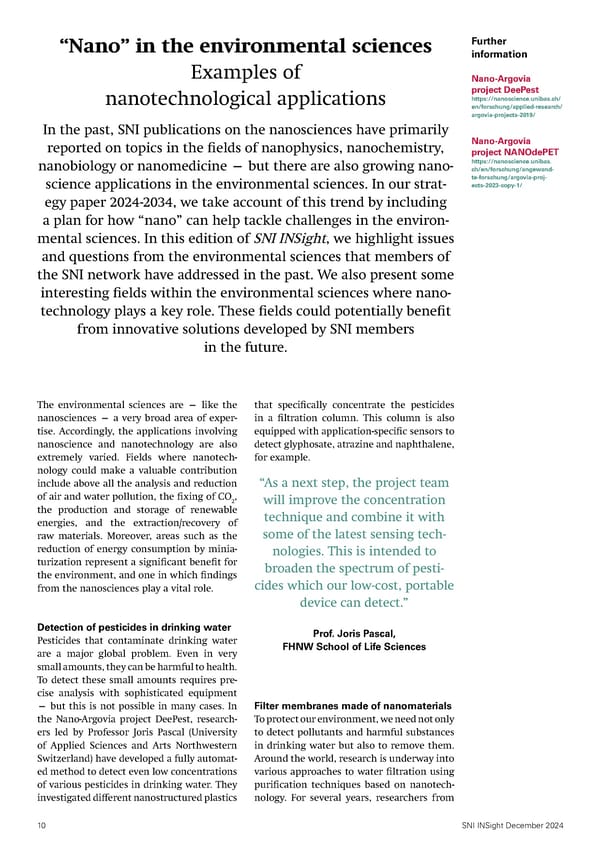“Nano” in the environmental sciences Further information Examples of Nano-Argovia project DeePest nanotechnological applications https://nanoscience.unibas.ch/ en/forschung/applied-research/ argovia-projects-2019/ In the past, SNI publications on the nanosciences have primarily reported on topics in the 昀椀elds of nanophysics, nanochemistry, Nano-Argovia project NANOdePET nanobiology or nanomedicine — but there are also growing nano- https://nanoscience.unibas. ch/en/forschung/angewand- te-forschung/argovia-proj- science applications in the environmental sciences. In our strat- ects-2023-copy-1/ egy paper 2024-2034, we take account of this trend by including a plan for how “nano” can help tackle challenges in the environ- SNI INSight, we highlight issues mental sciences. In this edition of and questions from the environmental sciences that members of the SNI network have addressed in the past. We also present some interesting 昀椀elds within the environmental sciences where nano- technology plays a key role. These 昀椀elds could potentially bene昀椀t from innovative solutions developed by SNI members in the future. The environmental sciences are — like the that speci昀椀cally concentrate the pesticides nanosciences — a very broad area of exper- in a 昀椀ltration column. This column is also tise. Accordingly, the applications involving equipped with application-speci昀椀c sensors to nanoscience and nanotechnology are also detect glyphosate, atrazine and naphthalene, extremely varied. Fields where nanotech- for example. nology could make a valuable contribution include above all the analysis and reduction “As a next step, the project team of air and water pollution, the 昀椀xing of CO , 2 will improve the concentration the production and storage of renewable technique and combine it with energies, and the extraction/recovery of raw materials. Moreover, areas such as the some of the latest sensing tech- reduction of energy consumption by minia- nologies. This is intended to turization represent a signi昀椀cant bene昀椀t for broaden the spectrum of pesti- the environment, and one in which 昀椀ndings cides which our low-cost, portable from the nanosciences play a vital role. device can detect.” Detection of pesticides in drinking water Prof. Joris Pascal, Pesticides that contaminate drinking water FHNW School of Life Sciences are a major global problem. Even in very small amounts, they can be harmful to health. To detect these small amounts requires pre- cise analysis with sophisticated equipment — but this is not possible in many cases. In Filter membranes made of nanomaterials the Nano-Argovia project DeePest, research- To protect our environment, we need not only ers led by Professor Joris Pascal (University to detect pollutants and harmful substances of Applied Sciences and Arts Northwestern in drinking water but also to remove them. Switzerland) have developed a fully automat- Around the world, research is underway into ed method to detect even low concentrations various approaches to water 昀椀ltration using of various pesticides in drinking water. They puri昀椀cation techniques based on nanotech- investigated di昀昀erent nanostructured plastics nology. For several years, researchers from 10 SNI INSight December 2024
 SNI INSight December 2024 Page 9 Page 11
SNI INSight December 2024 Page 9 Page 11